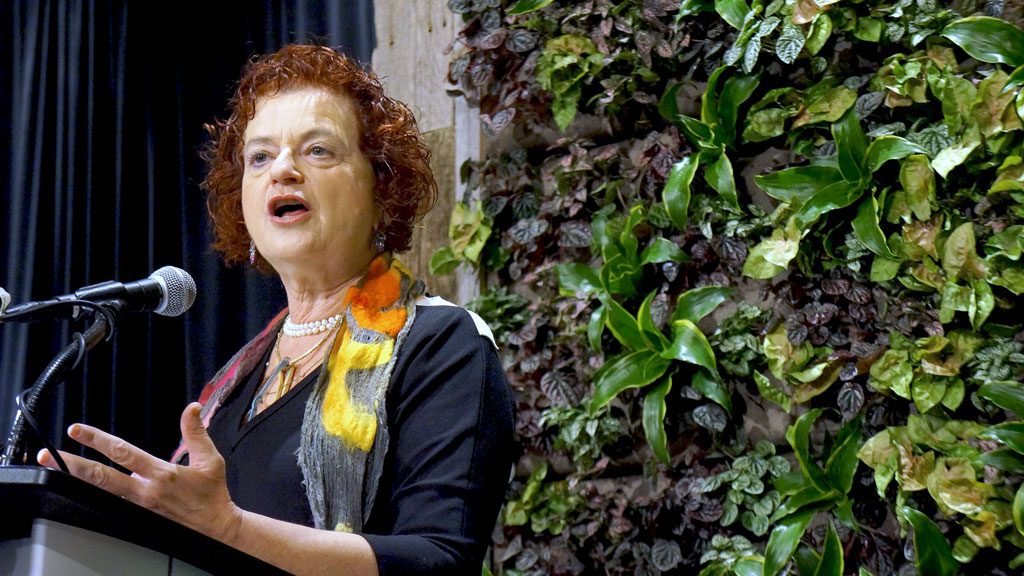Just because a big office building is old, antiquated and ugly doesn’t mean it can’t be resurrected.
That’s the thinking of architect Vivian Manasc, whose firm Manasc Isaac Architects Ltd. transformed a 1970s office building in downtown Edmonton that had been called “the ugliest building in the city” into an eye-catching tower attracting new tenants.
“Reimagining buildings is at the heart of the future,” Manasc told delegates at the Healthy Buildings, Healthy Planet conference hosted by Sustainable Buildings Canada in downtown Toronto recently.
Manasc, who led a seminar on emerging trends in sustainable design, said her firm’s renewal of the office tower included an energy performance upgrade and the replacement of some of the precast cladding, overcladding portions of the facade with a curtainwall as well as the addition of a bow-shape to the facade. Throughout the process existing tenants remained in place.
She said an option to demolish the building was not economical, nor would it have been good news “from a carbon footprint perspective.”
Among other emerging trends, Manasc told delegates to expect to hear more about biomimicry: sustainable designs that pick up on or adapt to settings in nature. Buildings that drain stormwater like nature does and building envelopes that are responsive to the environment are examples.
So much of traditional design and construction practice is based on a use case
— Vivian Manasc
Manasc Isaac Architects Ltd.
Past-president of the Royal Architectural Institute of Canada and past vice-president of the Canada Green Building Council, Manasc said one reason why buildings are not as green as possible is “the procurement (process) we are locked into limits our ability to specify the best solutions for our clients and projects.”
“Smarter sustainable outcomes,” she told delegates, might be possible through the blockchain that allows ledgers “that enable people to buy things in a more thoughtful way.”
She advised delegates to stay in tune with other industries such as information technology and management consulting because of their influence on new buildings.
Manasc said sustainable buildings are best designed when architects, engineers, suppliers and manufacturers collaborate to “co-create the right solutions. Design thinking is about getting in a room together…and cross-pollinating and testing ideas. The environmental impact of materials, labour and operations really diminishes relative to the impact of the influence of the decisions made very early.”
She pointed out buildings are evolving in part because of the way they are used. Increasingly, there is a move to “creative collaboration” in which different professions work together. The shift questions conventional designs and even energy modelling.
“So much of traditional design and construction practice is based on a use case,” she said. “What is the use space when you have (collaborative) spaces that are so fluid?”
New ways of design thinking create new types of jobs, Manasc added, noting the green building movement will thrive in the coming years. Even as artificial intelligence takes off, “we are not going to replace the human imagination.”
She said changes to where photovoltaic (PV) systems can be installed might be coming in Canada. Already in Alberta, rooftop solar systems are in question because the Alberta Roofing Contractors Association (ARCA) has imposed requirements limiting photovoltaic systems to 50 per cent coverage on rooftops. Setbacks, spacing and structural connection restrictions have also been mandated by the ARCA, which won’t provide a roof warranty if their requirements are not met.
“It is really limiting the viability of putting any PV on the roof,” she said.
Manasc advised delegates to look at opportunities to work with Indigenous communities on design.
“I think it (the relationship) is going to inform how we think about green buildings for a very long time,” she said, noting her firm has collaborated with First Nation communities long before sustainable design was on anyone’s agenda.
Manasc’s firm started designing energy-efficient buildings in northern Canada 30 years ago.
In 2005, it created an integrated photovoltaic installation for an office building in Yellowknife, the first of its kind in the North. The PV cells were laminated into the glazing through a manufacturer in France.
“How sustainable that was, we’re not sure, but we got 33 kilowatts of PV in that building which was pretty cool for 2005,” she added.











Recent Comments